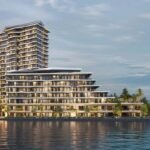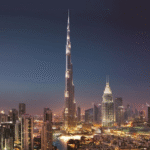Now Reading: UAE Residential Real Estate Records Unprecedented Growth: Report
-
01
UAE Residential Real Estate Records Unprecedented Growth: Report
UAE Residential Real Estate Records Unprecedented Growth: Report

UAE residential real estate has experienced unprecedented growth, according to the latest industry report. The surge reflects strong demand from both local and international investors, rising property prices, and a rapidly expanding market. Dubai, Abu Dhabi, and emerging emirates like Sharjah and Ajman are witnessing robust activity in both luxury and mid-market housing segments, highlighting the resilience and attractiveness of the UAE property sector.
This article delves into the factors driving growth, the impact on buyers and investors, key market trends, and what the future holds for residential real estate in the UAE.
Key Drivers Behind Residential Real Estate Growth
Several factors have contributed to the unprecedented rise in UAE residential real estate over the past few years:
1. Strong Investor Confidence
Investor confidence remains a cornerstone of the market’s growth. Attractive returns, low taxes, and government incentives have encouraged both local and international investors to purchase residential properties, especially in high-demand locations such as Downtown Dubai, Palm Jumeirah, and Saadiyat Island.
2. Economic Recovery and Diversification
The UAE’s diversified economy, encompassing finance, tourism, trade, and technology, has provided a solid foundation for residential real estate growth. Following global economic slowdowns, swift recovery measures and strategic policies have bolstered investor sentiment.
3. Population Growth and Expat Influx
The UAE continues to attract expatriates seeking employment, lifestyle opportunities, and safe investment options. Population growth, particularly in Dubai and Abu Dhabi, has increased demand for both rental and purchase residential properties.
4. Government Initiatives and Regulations
Regulatory measures have strengthened transparency, eased property ownership for foreigners, and introduced long-term residency visas linked to property investment. These initiatives have stimulated demand while ensuring market stability.
5. Infrastructure and Urban Development
Mega infrastructure projects, including roads, metro extensions, airports, and smart city initiatives, have enhanced connectivity and lifestyle appeal. Communities such as Dubai Hills Estate, Mohammed Bin Rashid City, and Yas Island have seen rising demand due to these developments.
Market Trends in UAE Residential Real Estate
The report highlights several notable trends in UAE residential real estate:
Luxury Housing Boom
High-net-worth individuals continue to drive demand for luxury villas, townhouses, and apartments. Iconic properties in prime locations such as Palm Jumeirah and Downtown Dubai command premium prices and remain a preferred choice for investors seeking both lifestyle and capital appreciation.
Mid-Market Housing Growth
The mid-market housing segment is expanding rapidly to meet the needs of middle-income residents and young professionals. Developments in areas like Dubai Silicon Oasis, Jumeirah Village Circle, and Mohammed Bin Zayed City offer affordable yet quality housing, attracting both buyers and rental investors.
Increase in Off-Plan Purchases
Off-plan property sales have surged as developers offer flexible payment plans, competitive pricing, and attractive incentives. This trend has encouraged early-stage investment in upcoming residential communities, boosting market liquidity.
Rise of Sustainable and Smart Homes
Developers are increasingly integrating sustainability and smart home technology into residential projects. Energy-efficient designs, solar panels, and automated home systems are becoming standard, catering to environmentally conscious buyers and investors seeking long-term value.
Rental Market Dynamics
Rental yields have remained attractive, particularly in premium areas. High demand from expatriates and professionals continues to support strong occupancy rates, making residential properties an appealing investment.
Impact on Buyers and Investors

The growth of UAE residential real estate has significant implications for both homeowners and investors:
For Buyers
- Affordability Challenges: Rising property prices may impact affordability, especially for first-time buyers.
- Lifestyle Options: Buyers have access to diverse communities offering modern amenities, smart technologies, and integrated living solutions.
- Long-Term Value: Properties in prime locations offer potential for capital appreciation and stable investment returns.
For Investors
- High Returns: Rising property values and strong rental yields provide attractive returns.
- Diversified Opportunities: Investors can choose from luxury villas, mid-market apartments, and off-plan projects to diversify portfolios.
- Global Investment Appeal: The UAE’s tax-free environment and international recognition attract foreign investors, enhancing market depth and stability.
Government Measures Supporting Market Growth
To sustain the growth of UAE residential real estate, the government has implemented several measures:
- Streamlining property registration processes to ensure transparency and efficiency.
- Introducing long-term residency visas linked to property ownership.
- Implementing regulatory frameworks that protect investors and ensure fair market practices.
- Promoting sustainable and eco-friendly urban developments.
These measures have created a secure and attractive environment for property investment, contributing to the market’s robust growth.
Regional Highlights
Dubai
Dubai has seen record growth in both luxury and mid-market residential segments. Iconic communities like Downtown Dubai, Dubai Marina, and Palm Jumeirah remain top choices for investors. Off-plan projects and new community developments continue to attract strong demand.
Abu Dhabi
Abu Dhabi’s residential market is benefiting from government-led infrastructure projects and urban expansion. Areas such as Saadiyat Island, Yas Island, and Al Reem Island are witnessing rising property values and rental demand.
Emerging Emirates
Sharjah, Ajman, and Ras Al Khaimah are gaining attention due to affordability, connectivity, and new residential developments. These emirates provide investment opportunities for buyers looking for long-term growth and steady rental income.
Future Outlook
The report indicates that UAE residential real estate will continue to thrive in the coming years, driven by:
- Increasing demand from international investors and expatriates.
- Continued government support through regulatory reforms and infrastructure development.
- Expansion of sustainable and smart residential projects.
- Growth in mid-market housing to cater to diverse income groups.
Analysts predict a balanced growth trajectory, where high-end properties will continue to appreciate while mid-market housing meets the needs of a growing population.
Challenges to Consider
While the market shows robust growth, certain challenges must be monitored:
- Price Volatility: Rapid price increases could create affordability issues for some buyers.
- Global Economic Factors: International market fluctuations may influence foreign investment inflows.
- Oversupply Risk: Developers must manage supply to prevent saturation in certain segments.
- Interest Rate Sensitivity: Rising global interest rates may affect mortgage affordability and investor appetite.
Addressing these challenges through careful planning and regulatory oversight will be essential for maintaining sustainable growth.
Conclusion
UAE residential real estate has achieved unprecedented growth, driven by strong investor confidence, government support, infrastructure development, and increasing demand from local and international buyers. The market offers attractive opportunities for both homeowners and investors, with a variety of luxury, mid-market, and sustainable housing options available.
While challenges such as affordability and market volatility exist, regulatory measures and market fundamentals suggest that the growth trajectory is sustainable. The UAE remains a leading global destination for residential real estate investment, offering long-term value, lifestyle benefits, and a secure investment environment.
As Dubai, Abu Dhabi, and other emirates continue to develop iconic residential communities, the UAE’s property sector is poised to maintain its position as a dynamic, high-growth market for years to come.
Follow us on: Instagram
Read More-Dubai Real Estate Strategy 2033: Transforming the Property Market






















